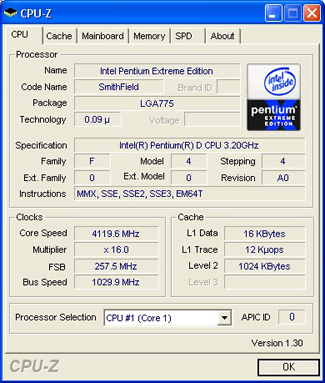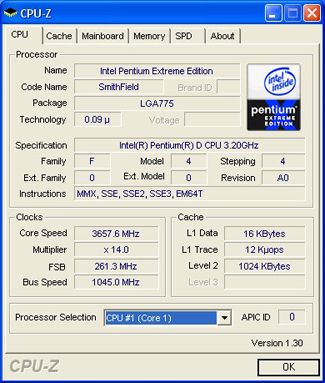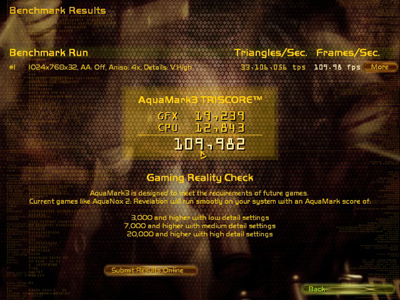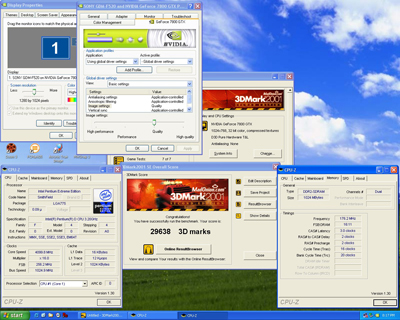Asus P5N32-SLI: Dual x16 - What Dreams Are Made On . . .
by Gary Key on October 27, 2005 12:05 AM EST- Posted in
- Motherboards
ASUS P5N32-SLI Deluxe: Overclocking
FSB Overclocking Results
Memory Stress Testing
Memory stress tests look at the ability of the Asus P5N32-SLI Deluxe to operate at the officially supported memory frequencies of 667MHz DDR2 at the best performing memory timings that the Corsair CM2X512A-5400UL revision 1.3 will support.
The Asus P5N32-SLI Deluxe was completely stable with 2 DDR2 modules in Dual-Channel at the settings of 3-2-2-8 at 2.1V and was stable at this setting up to a timing mode of 720MHz before changing the Command Rate to 2.
We will now install all four available memory slots, which are usually more strenuous on the memory subsystem than testing 2 DDR2 modules on a motherboard.
The Asus P5N32-SLI Deluxe was completely stable with 4 DDR2 modules in Dual-Channel at the settings of 3-2-2-8 and only needed the voltage increased to 2.2. This is an excellent accomplishment and truly shows off the engineering aspects of this board.
FSB Overclocking Results
| Front Side Bus Overclocking Testbed | |
| Processor: | Pentium 4 Prescott LGA 775 840EE Dual Core 3.2GHz |
| CPU Voltage: | 1.4125V (1.3875V default) |
| Memory Settings: | 3-2-2-8 1T at 715MHz |
| Memory Voltage: | 2.1V |
| NorthBridge Voltage: | 1.40V |
| SouthBridge Voltage: | 1.50V |
| Cooling: | Intel 840EE Heat Sink |
| Power Supply: | OCZ Power Stream 520 |
| Maximum CPU OverClock | 257fsb x 16 (4119MHz) +29% |
| Maximum FSB OC: | 261fsb x 14 (3657MHz) +15% |



Memory Stress Testing
Memory stress tests look at the ability of the Asus P5N32-SLI Deluxe to operate at the officially supported memory frequencies of 667MHz DDR2 at the best performing memory timings that the Corsair CM2X512A-5400UL revision 1.3 will support.
| Asus P5N32-SLI Deluxe Stable DDR667 Timings - 2 DIMMs (2/4 slots populated - 1 Dual-Channel Bank) |
|
| Clock Speed: | 200MHz (800FSB) |
| Timing Mode: | 667MHz - Default |
| CAS Latency: | 3 |
| RAS to CAS Delay: | 2 |
| RAS Precharge: | 2 |
| RAS Cycle Time: | 8 |
| Voltage: | 2.1V |
| Command Rate: | 1 |
The Asus P5N32-SLI Deluxe was completely stable with 2 DDR2 modules in Dual-Channel at the settings of 3-2-2-8 at 2.1V and was stable at this setting up to a timing mode of 720MHz before changing the Command Rate to 2.
We will now install all four available memory slots, which are usually more strenuous on the memory subsystem than testing 2 DDR2 modules on a motherboard.
| Asus P5N32-SLI Deluxe Stable DDR667 Timings - 4 DIMMs (4/4 slots populated - 2 Dual-Channel Banks) |
|
| Clock Speed: | 200MHz (800FSB) |
| Timing Mode: | 667MHz - Default |
| CAS Latency: | 3 |
| RAS to CAS Delay: | 2 |
| RAS Precharge: | 2 |
| RAS Cycle Time: | 8 |
| Voltage: | 2.2V |
| Command Rate: | 1 |
The Asus P5N32-SLI Deluxe was completely stable with 4 DDR2 modules in Dual-Channel at the settings of 3-2-2-8 and only needed the voltage increased to 2.2. This is an excellent accomplishment and truly shows off the engineering aspects of this board.











70 Comments
View All Comments
Wesley Fink - Thursday, October 27, 2005 - link
Those accustomed to looking at AMD Athlon64 Performance Scores are used to seeing numbers almost the same across motherboards because the memory controller is on the CPU. The Intel Memory Controller is in the chipset and performance varies much more depending on the chipset and the quality of the motherboard design.That is one reason we often test Latency in Intel MB tests. If you look at the Latency test results in this review you will see a fairly wide variation across the tested chipsets and motherboards for the Intel CPU. Athlon64 Latency tests would all be virtually the same with the memory controller a part of the processor.
toyota - Thursday, October 27, 2005 - link
how can motherboards make that much difference in gaming?? in the Doom3 benchmarks they range from 63 to 95 fps! i dont understand benchmarks like that and nobody else ever makes a comment. am i missing something?Gary Key - Thursday, October 27, 2005 - link
Good Day.....I revised the article statement about the Doom3 scores. I left it out on the final copy by mistake. We are still investigating the differences as an upcoming article from Randi on another nF4 Intel SLI board has scores higher than the numbers I have reported by a fair margin again. In fact, I will be testing the Abit board once it arrives with an disk image from my previous tests.
Due to the memory controller not being on the CPU (current Athlon64 family design) the Intel based motherboard design makes a great deal of difference not only from a chipset choice but also from how well a board manufacturer designs and implements the supporting components and bios.
Thank you.
xsilver - Thursday, October 27, 2005 - link
the 63fps is on another chipset, the chipset affects memory, hdd performance directly and everything else indirectly..the 95fps actually looks like an anomaly -- and AT member will have to confirm that (SLI setup in the NI8?)
so in fact the numbers are actually 75.3-79.4fps which is an acceptable range for the same chipset
many people forget the mobo is the heart of the system, it pays to get a good one :)
TransientBen - Thursday, October 27, 2005 - link
Mixing philosophy, classical literature and computer hardware reviews? Gotta love it. Though it's difficult to not get caught up in the philosophy and then question, "Is it worth $200 for a motherboard or a plane ticket to a new place?"There is so little time, afterall.
Always been a big Asus fan. Have one of the first (original slot a) Athlon boards still up and running after all these years - rock solid - and, more recently, a Z33A laptop that's blown me away with it's quality. I look forward to the inclusion of many of these features on future AMD boards.
noac - Saturday, November 12, 2005 - link
Hi, Im reading my manual and it says:DIMM_A1 (yellow), DIMM_A2 (black), DIMM_B1 (yellow), DIMM_B2 (black).
Channel A = DIMM_A1 and DIMM_A2
Channel B = DIMM_B1 and DIMM_B2
For dual-channel configuration, the total size of memory module(s) intalled per channel must be the same (DIMM_A1 + DIMM_A2, DIMM_B1 + DIMM_B2).
Anandtech:
Asus did an excellent job with the color coordination of the various peripheral slots and connectors. The DIMM module slots' color coordination is correct for dual channel setup.
My question which way is it? Im I getting the manual wrong? How to I palce my two mems for dualchannel?
Gary Key - Wednesday, November 16, 2005 - link
Email me if you have any issues or further questions please.Gary Key - Wednesday, November 16, 2005 - link
Sorry about the late reply...You place the memory in the two yellow DIMM slots for dual channel.
Gary Key - Thursday, October 27, 2005 - link
Depends on the time and place in my book. :-> However, considering where I could go for $200 at this point in time I will take the board. I also believe Dickens is queued up for the next article.
I had been concerned about Asus the past couple of releases as I honestly thought Intel had passed them on the high end side (useable features, stability, throw in Abit for performance) with their 925x and 955x boards until this gem landed on my doorstep.
I think the AMD version of this board should be equally adept and we should find out shortly. ;->
xsilver - Thursday, October 27, 2005 - link
I can see asus and the other mobo companies making this refresh right after/before christmas and then obviously another refresh for M2 socket